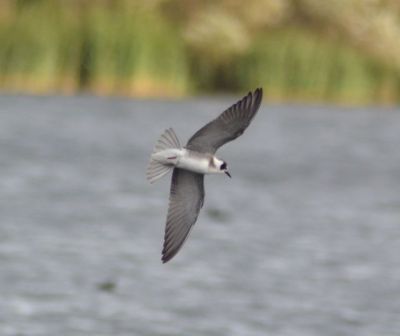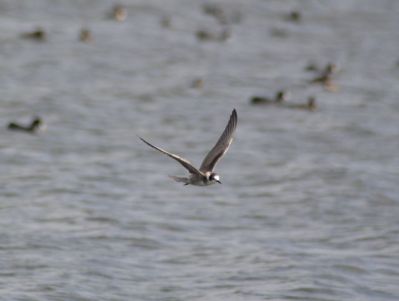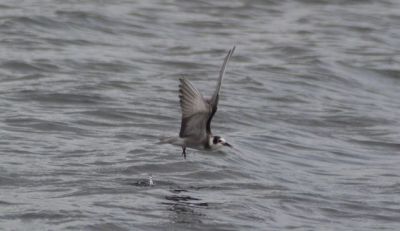This in birding parlance is what is known as an “insurance tick”, recording a sub-species that could be split in the future. Going for it today aptly demonstrated how difficult it has been to locate new birds within my preferred range this autumn. But with the Siberian drift migrants I need all occurring way too far north for my liking in the present Atlantic weather pattern, a 93-mile excursion to the outskirts of Bournemouth offered the best alternative for a day out.

Today’s American Black Tern
American Black Tern Ssp surinamensis is said to be distinguishable from its European counterpart Chlidonias niger in all plumages. For an informative guide to separating the two races see here. I arrived on site late morning, parking at the top of Green Lane (SZ 06551 98272) where there is no restriction, then walking around the northern of two lakes and south to where several observers had my quest in view on the second one.
The former reservoir of Longham Lakes is managed as a recreational facility by Bournemouth Water Leisure, primarily for angling but also for walking, and is a well known birding site in the area. I had visited twice before, to see a Hoopoe (Dec 2010) and my only White-rumped Sandpiper (Dec 2012). Today I was expecting to watch something quite distantly and left my camera in the car. But the ABT was actually very co-operative, making several close passes to the group I had joined. So I made the departure of taking some video on my phone instead, but this free blog plan does not support video files.

American Black Tern
Some of those around me commented on the level of energy this juvenile was putting into the amount of food it was finding. It had been here for three days and followed the same circuit over and again, mainly around the southern end of the lake but venturing up towards us at intervals. I found the jizz to be especially pleasing and so felt glad to have made the effort to experience this quite different Nearctic form of a familiar passage Tern.
After an hour I decided to retrieve my camera and attempt some flight studies, then on my return the bird naturally enough stopped playing ball. For the next hour it kept to the southern end of the lake before eventually making two more near fly pasts. As a mid-level birder who takes pictures I feel content enough with the records then gained (below and above). But I had noticed how some field companions with far more complex and expensive equipment than my own seemed dissatisfied with their own results. For the RBA gallery of this bird see here.

American Black Tern

As the detested dark season looms again I feel a little apprehensive over the brittle sense of motivation that wildlife observation brings. Whilst I admire patch watchers and local birders for remaining content to record the same things ad infinitum, for me the activity becomes pointless when done for its own sake. Punishing as it is, there must be at least something new and different in the mix, or evolved ways of going about things. This today was a thoroughly worthwhile excursion that succeeded in producing the desired warm inner glow.
